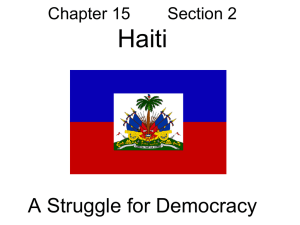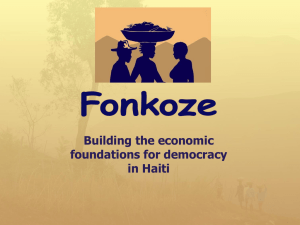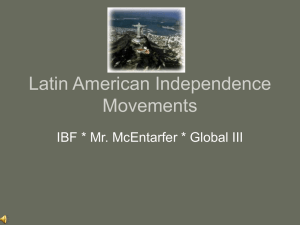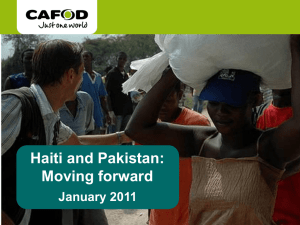Deforestation_in_Haiti - Prairie Public Broadcasting
advertisement
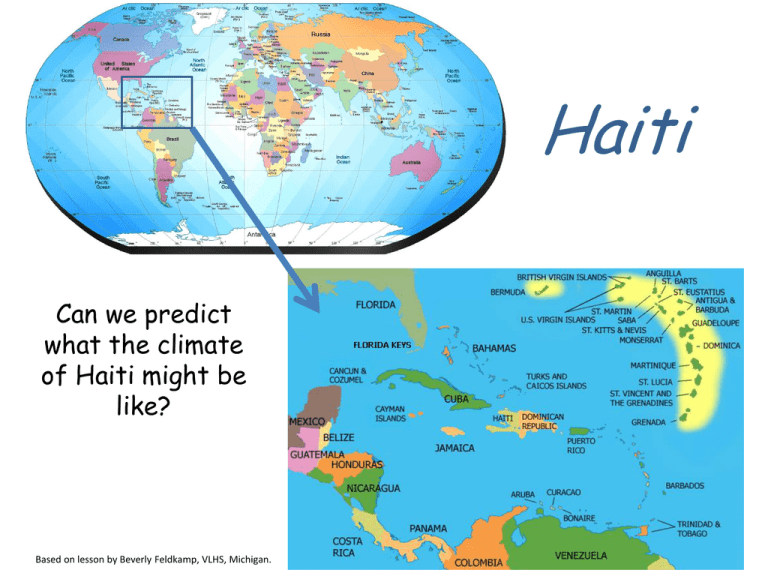
Haiti Can we predict what the climate of Haiti might be like? Based on lesson by Beverly Feldkamp, VLHS, Michigan. Christopher Columbus described the island of Haiti: “Its lands are high; there are in it many sierras and very lofty mountains…all are most beautiful, or a thousand shapes; all are accessible and filled with trees of a thousand kinds and tall, so that they seem to touch the sky. I am told that they never lose their foliage, and this I can believe, for I saw them as green and lovely as they are in Spain in May, and some of them were flowering, some bearing fruit, and some at another stage, according to their nature.” Excerpted from “People of the Tropical Rain Forest,” 1988, by Denslow and Padoch. 1904 World’s Fair at St. Louis sketch on Haiti: …there is no article of commerce produced in the tropics that is not found or could not be produced in Haiti. Apples, peaches, strawberries, and blackberries are to be found in the uplands. Tropical fruits also include sweet and sour oranges, citrons, lemons, bananas, plantains, pineapples, cocoanuts and pears. The soil seems to be especially adapted to the cultivation of sugar cane and the most popular of all the fruits of Haiti is the mango. Your turn…draw what you think the landscape and vegetation of Haiti looks like. Is this what you thought Haiti would be like? What happened??? In reality, much of Haiti is more like this picture. This shows the border between Haiti and the Dominican Republic. Haiti Dominican Republic In 1923, 60% of Haiti was forested. Only 1.5% of that forest remains today. Trees protect land from the impact of tropical storms, prevent soil erosion and regulate the water cycle. What caused the massive deforestation in Haiti? The recorded history of Haiti began on December 5, 1492 when the European navigator Christopher Columbus happened upon a large island in the region of the western Atlantic Ocean that later came to be known as the Caribbean Sea. Haiti went through a period of Spanish rule, then French rule. It claimed its independence in 1804. It was a slave nation for much of its history. In the next 200 years, Haiti would have 20 different constitutions and 14 presidents “for life.” Why has the population grown so much since 1950? Haiti Population 1950 = 3.2 million 1970 = 4.2 million 1990 = 6.5 million Year 1950 1955 1960 1965 1970 1975 1980 1985 1990 1995 2000 2005 2010 2015 2020 2025 2030 2035 2040 2045 2050 Population density 118 126 137 149 163 177 197 221 247 266 286 307 330 351 372 392 410 427 442 456 468 This is the number of people per square mile… Images from Haiti’s capital city, Port au Prince Haiti’s population also grew rapidly because it’s tropical hardwoods were desired around the world. Haiti would export ironwood, mahogany, logwood and acacia for making furniture. Who’s making the money from selling the tropical hardwoods? The increase in population has naturally led to an increased demand for food. Slash and burn is the most common method of clearing land in Haiti. This kind of agriculture makes soil useful for only two or three years. Because of all the excitement from the 1904 World Fair, Haiti suddenly had a large number of commercial farms. These farms were primarily growing coffee and sugar cane. Enormous numbers of slaves were needed to harvest the trees, coffee and sugar cane. In the late 1900’s, the US blocked shipments of fuel to Haiti because of the continued political problems. This led to increased deforestation as Haitians cut trees for fuel. Haitians found it more difficult to farm without fuel for equipment. 80% of Haiti’s population relies on charcoal which comes from trees (primarily pine trees), to cook food. For many Haitians, selling charcoal is the only source of income. Since most of Haiti’s population came from slavery…how will that cause deforestation? Do the Haitian’s understand the effects of what they are doing? Do the Haitian’s have a choice to solve the problem? Your assignment is to complete the chart showing the causes, effects and solutions to deforestation in Haiti. We already covered the CAUSES…so mark them down first… 1. 2. 3. 4. 5. 6. 7. 8. Increase in human population Clearing land for food production (slash and burn) Commercial logging of tropical hardwoods Lack of understanding or choices Political problems since 1957 Need for cheap source of fuel US stopped shipments of oil to Haiti Commercial farming – plantation crops (coffee/sugar) What are the EFFECTS of deforestation in Haiti? SOIL EROSION has turned the nation's highways into muddy roads, and the erosion in rural areas has driven thousands of people into the cities, which are already overwhelmed by poverty and overpopulation. Construction on hillsides and loss of trees to hold the soil in place are a huge factor. Natural factors such as the mountainous terrain and heavy tropical rains only compound the devastation. What are the EFFECTS of deforestation in Haiti? Remember, Haiti has a tropical climate with frequent rains and dangers of hurricanes. The danger of FLOODING is intensified because trees are not available for holding back the waters and LANDSLIDES frequently result. Landslides endanger the remaining forests, human life and valuable farmland. An aerial view of floods caused by Tropical Storm Hanna is seen in Gonaives, Haiti on September 3, 2008. Haiti's civil protection office said 37 of the 90 Hanna-related deaths had occurred in the port city of Gonaives. What are the EFFECTS of deforestation in Haiti? EXTINCTION AND ENDANGERMENT OF SPECIES: As we all know, rainforests provide the greatest variety of plant and animal life on earth. 14 of 75 species of bird in Haiti are in danger of extinction as well as 100 plant species as the forest itself. Parrot Tanager Parakeet Chat What are the EFFECTS of deforestation in Haiti? Haiti is surrounded on 3 sides by water and FISHING use to be a major industry for Haitians. However, soil washing into the sea has killed fish as well as the change in water temperature with no tree cover to cool the tropical waters. Because there are few trees left, the CLIMATE is CHANGING in Haiti which will also affect the growing season. What are the EFFECTS of deforestation in Haiti? Would you want to see this? There has been a huge DECLINE IN TOURISM because of the AIR POLLUTION and ECONOMIC INSTABILITY (poor country) in Haiti. There are HUNGER issues throughout the country because much of the SOIL LACKS NUTRIENTS to allow the people to grow food. What are the SOLUTIONS to deforestation in Haiti? Countries around the world need to be a part of the solution by providing FOREIGN GOVERNMENT AID which will hopefully provide EDUCATION ON MORE SUSTAINABLE AGRICULTURE PROCEDURES. This FOREIGN INVESTMENT would hopefully create a change for the people of Haiti. Haitians struggle to get the bottles of oil thrown from a UN truck. What are the SOLUTIONS to deforestation in Haiti? There is currently no organized program for the REPLANTATION OF FAST GROWING TREES. Haiti needs trees that can provide and income as well as produce roots and foliage to reduce some of the effects of deforestation. What are the SOLUTIONS to deforestation in Haiti? GRAFT MANGO TREES FOR BETTER QUALITY FRUIT Mangos have and continue to grow well in Haiti’s tropical climate. However, most of the mango trees produce low quality fruit so the trees are cut down for fuel or other wood products. There is a highly desired and profitable variety of mango which can be grown through grafting and produce between $50 and $100 per tree a year. What are the SOLUTIONS to deforestation in Haiti? Although not a direct cause or effect of deforestation, it will be hard to initiate change in Haiti without POLITICAL STABILITY. To reduce air pollution and dependence on charcoal for cooking, companies such as SUN OVENS, International, is developing ALTERNATE ENERGY SOURCES such as using the sun to cook their food. There is still a lot that needs to change to improve the lives of the Haitians…




